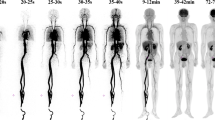Abstract.
14(R,S)-[18F]Fluoro-6-thia-heptadecanoic acid ([18F]FTHA) is a long-chain fatty acid substrate for fatty acid metabolism. [18F]FTHA has been used to study fatty acid metabolism in human heart and skeletal muscle. It has been suggested that the rate of radioactivity accumulation in the myocardium reflects the beta-oxidation rate of free fatty acids (FFAs). However, the net accumulation of FFAs in tissue always represents the sum of FFA oxidation and incorporation into triglycerides. The fraction of [18F]FTHA entering directly into mitochondria for oxidation has not been previously measured. Eight anaesthetized pigs were studied with [18F]FTHA and positron emission tomography (PET). Immediately after each PET experiment, tissue samples from myocardium and skeletal muscle were taken for the isolation of mitochondria and measurements of radioactivity accumulation, and for intracellular [18F]FTHA metabolite analysis. Fractional [18F]FTHA uptake rates were calculated both by graphical analysis of PET data and by measuring 18F in the tissue samples. Fractional [18F]FTHA uptake rates based on the analysis of tissue samples were 0.56±0.17 ml g–1 min–1 and 0.037±0.007 ml g–1 min–1 for myocardium and skeletal muscle (mean ± SD), respectively. The myocardial results obtained from the PET data (0.50±0.11 ml g–1 min–1) were similar to the values obtained from the tissue samples (r=0.94, P=0.002). We also found that 89%±23% (mean±SD, n=7) of the 18F entered mitochondria in myocardium, as compared with only 36%±15% (mean±SD, n=7) in skeletal muscle. Intracellular [18F]FTHA metabolite analysis showed that a major part of [18F]FTHA is metabolized in the mitochondria in the heart. Our data suggest that ~89% of [18F]FTHA taken up by the heart enters mitochondria. This supports the hypothesis that [18F]FTHA traces FFA beta-oxidation in the heart. In contrast to this, only ~36% of [18F]FTHA accumulated in skeletal muscle appears to directly enter mitochondria; the majority is taken up by the other cell fractions, suggesting that in skeletal muscle [18F]FTHA traces FFA uptake but not specifically FFA beta-oxidation.
Similar content being viewed by others
Author information
Authors and Affiliations
Additional information
Electronic Publication
Rights and permissions
About this article
Cite this article
Takala, T., Nuutila, P., Pulkki, K. et al. 14(R,S)-[18F]Fluoro-6-thia-heptadecanoic acid as a tracer of free fatty acid uptake and oxidation in myocardium and skeletal muscle. Eur J Nucl Med 29, 1617–1622 (2002). https://doi.org/10.1007/s00259-002-0979-y
Received:
Accepted:
Issue Date:
DOI: https://doi.org/10.1007/s00259-002-0979-y




